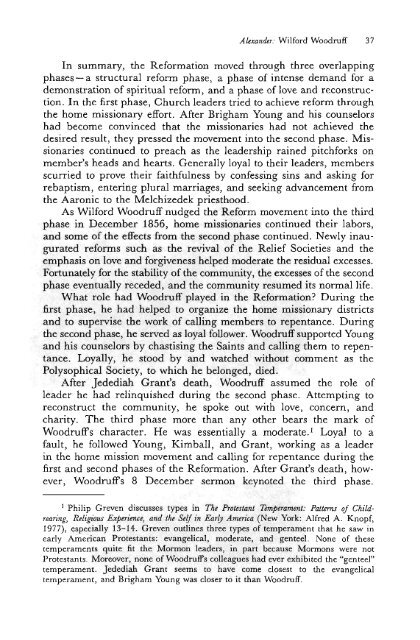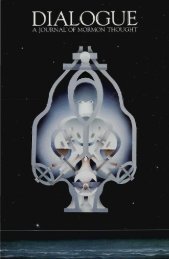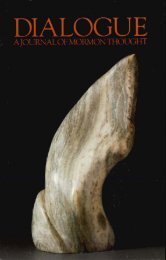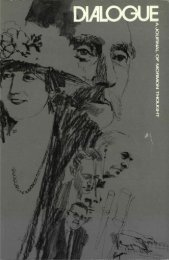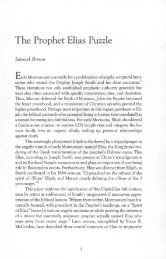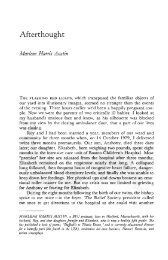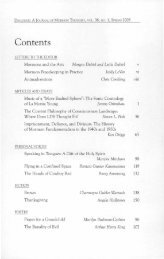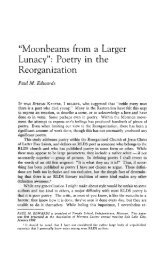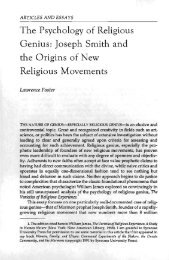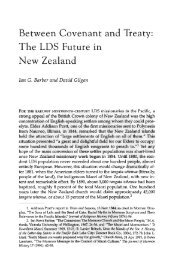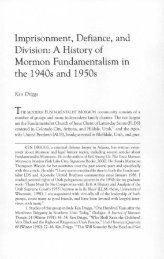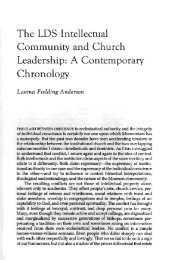Dialogue, Volume 25, Number 2 - Dialogue – A Journal of Mormon ...
Dialogue, Volume 25, Number 2 - Dialogue – A Journal of Mormon ...
Dialogue, Volume 25, Number 2 - Dialogue – A Journal of Mormon ...
Create successful ePaper yourself
Turn your PDF publications into a flip-book with our unique Google optimized e-Paper software.
Alexander: Wilford Woodruff 37<br />
In summary, the Reformation moved through three overlapping<br />
phases —a structural reform phase, a phase <strong>of</strong> intense demand for a<br />
demonstration <strong>of</strong> spiritual reform, and a phase <strong>of</strong> love and reconstruction.<br />
In the first phase, Church leaders tried to achieve reform through<br />
the home missionary effort. After Brigham Young and his counselors<br />
had become convinced that the missionaries had not achieved the<br />
desired result, they pressed the movement into the second phase. Missionaries<br />
continued to preach as the leadership rained pitchforks on<br />
member's heads and hearts. Generally loyal to their leaders, members<br />
scurried to prove their faithfulness by confessing sins and asking for<br />
rebaptism, entering plural marriages, and seeking advancement from<br />
the Aaronic to the Melchizedek priesthood.<br />
As Wilford Woodruff nudged the Reform movement into the third<br />
phase in December 1856, home missionaries continued their labors,<br />
and some <strong>of</strong> the effects from the second phase continued. Newly inaugurated<br />
reforms such as the revival <strong>of</strong> the Relief Societies and the<br />
emphasis on love and forgiveness helped moderate the residual excesses.<br />
Fortunately for the stability <strong>of</strong> the community, the excesses <strong>of</strong> the second<br />
phase eventually receded, and the community resumed its normal life.<br />
What role had Woodruff played in the Reformation? During the<br />
first phase, he had helped to organize the home missionary districts<br />
and to supervise the work <strong>of</strong> calling members to repentance. During<br />
the second phase, he served as loyal follower. Woodruff supported Young<br />
and his counselors by chastising the Saints and calling them to repentance.<br />
Loyally, he stood by and watched without comment as the<br />
Polysophical Society, to which he belonged, died.<br />
After Jedediah Grant's death, Woodruff assumed the role <strong>of</strong><br />
leader he had relinquished during the second phase. Attempting to<br />
reconstruct the community, he spoke out with love, concern, and<br />
charity. The third phase more than any other bears the mark <strong>of</strong><br />
Woodruffs character. He was essentially a moderate. 1 Loyal to a<br />
fault, he followed Young, Kimball, and Grant, working as a leader<br />
in the home mission movement and calling for repentance during the<br />
first and second phases <strong>of</strong> the Reformation. After Grant's death, however,<br />
Woodruffs 8 December sermon keynoted the third phase.<br />
1 Philip Greven discusses types in The Protestant Temperament: Patterns <strong>of</strong> Childrearing,<br />
Religious Experience, and the Self in Early America (New York: Alfred A. Knopf,<br />
1977), especially 13-14. Greven outlines three types <strong>of</strong> temperament that he saw in<br />
early American Protestants: evangelical, moderate, and genteel. None <strong>of</strong> these<br />
temperaments quite fit the <strong>Mormon</strong> leaders, in part because <strong>Mormon</strong>s were not<br />
Protestants. Moreover, none <strong>of</strong> Woodruffs colleagues had ever exhibited the "genteel"<br />
temperament. Jedediah Grant seems to have come closest to the evangelical<br />
temperament, and Brigham Young was closer to it than Woodruff.


